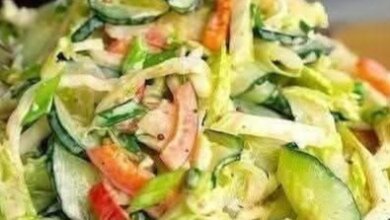Caesar Salad – The Ultimate Guide to Making a Classic Caesar Salad at Home

Introduction
Few salads have reached the iconic status of the Caesar salad. With its crisp romaine lettuce, creamy dressing, crunchy croutons, and a dusting of Parmesan, this dish is a perfect blend of textures and flavors — salty, tangy, garlicky, and refreshing. It’s elegant enough for a dinner party, yet simple enough for a weeknight side or a light lunch.
—
Origin
Despite its name, the Caesar salad doesn’t trace its roots to Julius Caesar or ancient Rome. Instead, it was created in 1924 by Caesar Cardini, an Italian-born restaurateur working in Tijuana, Mexico. According to culinary lore, Cardini improvised the recipe on a busy Fourth of July weekend, tossing together romaine, eggs, Parmesan, and croutons with a garlicky dressing — and a legend was born.
—
Cultural Significance
Over the decades, Caesar salad has become an enduring symbol of refined yet approachable dining. It bridges casual meals and fine cuisine, appearing everywhere from steakhouses to home kitchens. Its tableside preparation at restaurants adds a touch of theatre, and its adaptability (with chicken, shrimp, or even kale) has cemented its spot as one of the world’s most beloved salads.
—
Ingredients & Quantity (Serves 4)
For the Salad
2 medium heads romaine lettuce, chopped (about 8 cups)
1 cup croutons, preferably homemade
½ cup freshly grated Parmesan cheese
For the Dressing
2 egg yolks (or 2 tbsp mayonnaise for a no-raw-egg version)
2 anchovy fillets, finely minced (or 1 tsp anchovy paste)
1 clove garlic, minced
1 tsp Dijon mustard
2 tbsp fresh lemon juice
½ cup extra-virgin olive oil
Salt & freshly ground black pepper, to taste
—
Optional Additions
Grilled chicken, shrimp, or salmon for extra protein
Shaved Pecorino Romano instead of Parmesan for a sharper bite
A sprinkle of crispy bacon for smoky crunch
Kale or baby spinach in place of or mixed with romaine
—
Tips for Success
Dry the lettuce thoroughly after washing — a salad spinner is your best friend for crispness.
Use fresh lemon juice and high-quality olive oil for the dressing.
If you’re wary of raw eggs, gently coddle them in boiling water for 1 minute or swap for mayonnaise.
Toast your own croutons with olive oil, garlic, and a touch of salt for unbeatable flavor.
Toss the salad just before serving to maintain crunch.
—
Instructions
1. Prepare the croutons: Toss bread cubes with olive oil, garlic, and a pinch of salt. Bake at 375°F (190°C) for 10–12 minutes, until golden.
2. Make the dressing: In a bowl, whisk egg yolks, anchovies, garlic, Dijon, and lemon juice until smooth. Slowly drizzle in olive oil while whisking to create an emulsion. Season with salt and pepper.
3. Assemble the salad: In a large bowl, add lettuce, drizzle with dressing, and toss gently to coat.
4. Finish and serve: Add croutons and Parmesan, toss lightly again, and serve immediately.
—
Description
This Caesar salad is a vibrant medley of flavors: crunchy romaine, rich and velvety dressing, and nutty Parmesan. Each bite delivers a satisfying contrast of textures — the cool crispness of greens meets the indulgent tang of dressing and the toasty bite of croutons.
—
Nutritional Information (per serving, without protein additions)
Calories: ~270 kcal
Protein: 7 g
Carbohydrates: 12 g
Fat: 22 g (mostly heart-healthy from olive oil)
Fiber: 3 g
Sodium: ~480 mg
(Values will vary with portion sizes and optional toppings.)
—
Conclusion & Recommendation
The Caesar salad’s enduring popularity lies in its balance: hearty yet light, creamy yet crisp. Whether served as a side dish, a starter, or topped with grilled chicken for a full meal, it’s a timeless recipe that belongs in every cook’s repertoire.
—
Embracing Healthful Indulgence
By preparing Caesar salad at home, you gain control over ingredients, portion sizes, and freshness. Use whole-grain croutons, extra vegetables, or lean proteins to turn this classic into a wholesome indulgence that satisfies both palate and well-being.




